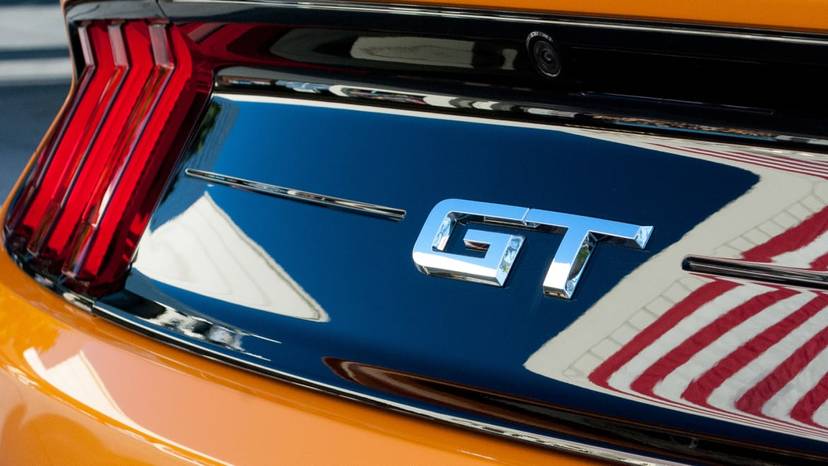
Cadillac overhauled the CTS-V for 2016, giving it gobs more power and a new platform featuring all sorts of performance goodies. A few features and packages are new for 2017, but otherwise it’s the same 640-hp supersedan loaded with big power, big brakes and big capabilities. Compare the current-generation CTS-V with the previous one here.
I drove a feature-packed CTS-V that came in at $103,360. To keep me from totaling this rear-wheel-drive rocket ship in colder Chicago weather, Cadillac ditched its standard Michelin Pilot Super Sport summer tires in favor of winter tires.
Exterior & Styling
A Carbon Black exterior package is a new option for 2017. The $6,950 package includes the Carbon Fiber Package and really does add a lot to the V’s appearance. The Carbon Black Package says goodbye to the regular tacky chrome mesh grille and replaces it with a black chrome piece, plus it also includes Cadillac’s aerodynamics-enhancing Carbon Fiber Package, which gives the V a more aggressive front splitter, a hood vent, a rear diffuser and a taller rear spoiler.
How It Drives
The Cadillac CTS-V’s supercharger is smaller and more efficient than in the previous-generation CTS-V, and Cadillac says that helps it build power-making boost more quickly. Hot damn, did it work. It’s the supercharger that helps the CTS-V stand out among high-powered sedans. There’s immediacy to the acceleration that the Cadillac’s turbocharged counterparts lack.
Many high-powered turbocharged cars, like the Audi RS 7 and BMW M5, have a lag between cracking the throttle and experiencing max acceleration. On the V, the whine of the supercharger is audible as soon as the accelerator is even slightly opened. Much to the chagrin of the rear tires, further opening the throttle unleashes the car’s 640 hp instantaneously. Cadillac says zero-to-60 mph happens in 3.7 seconds. BMW says the M5 does it in 4.2 seconds and Audi specs the more powerful version of the RS 7 at 3.6 seconds with all-wheel drive; the V and M5 are only available with rear-wheel drive. Compare the Cadillac CTS-V with its competitors here.
The Cadillac’s 640 hp is perfectly harnessed by an eight-speed automatic transmission, which might be the true star of the show. The combination of low-end power and torque from the engine with a transmission that screams through its first few gears makes the CTS-V a riot to drive, even when you can’t blast around at wide-open throttle. A few throttle blips here and there from a stoplight give a little taste of its capabilities. When unleashed, and when the tires finally find traction, the CTS-V’s pure acceleration is the gut-wrenching type that makes you feel like you’ve fallen off a cliff. The track-capable V pulls hard and can hit an advertised top speed of 200 mph.
You’d think a 600-plus horsepower, supercharged V-8 would be more than capable of providing enough visceral engine and exhaust noise to not need electronically augmented engine sounds, like turbocharged competitors have, but apparently you’d be wrong. The Cadillac CTS-V electronically augments engine noise, piping the natural sound of the engine through the stereo, but it clearly sounds digitized. How is it possible that a 640-hp V-8 needs help sounding good?
Our 2017 Cadillac CTS-V wore Pirelli Sottozero winter tires in factory sizes. Winter tires typically numb steering responsiveness, turn handling to mush, and give up dry acceleration and braking traction. I can’t say for sure if it was the car or the tires, but the CTS-V retained top-of-the-class steering precision with these winter tires; I felt no diminished or loosened connectivity to the road. Either the tires were really good or the Cadillac’s steering is so good that there’s still plenty of feedback left with mushy winter tires, giving the V a performance-sedan edge even with tires that are a much safer alternative in cold weather.
Interior
The Cadillac CTS-V comes up short on interior quality at its $103,000 as-tested price, and I think a lot of that cheapness comes from the dashboard’s center control panel, which is littered with touch-sensitive controls. The face is piano black with matte silver highlights and looks like it belongs in a much cheaper car.
Beyond the horrible usability of this center stack, which we’ll get to later, having traditional dials and mechanical buttons allows another touch point that can be covered in metal or a polished, high-quality material, which you don’t get with touch panels. There’s a hidden storage compartment behind the faceplate that’s flimsy and loose when opened, though the hidden cubby itself is a nice touch, with its USB port and a wireless charging pad.
The interior is otherwise nicely covered in high-quality materials, including generous use of imitation suede (called sueded microfiber) on the door pockets, ceiling and seats. The Carbon Black Package adds carbon fiber interior trim and a steering wheel covered in the sueded microfiber. Like I said earlier, not a whole lot of substance for the price.
The sueded-microfiber-lined front seats are probably the single greatest pair of sports seats I’ve experienced in a factory performance sedan. These optional Recaro seats ($2,300) should be studied and copied by all performance-car automakers (sorry, Cadillac). After being abused by the Nissan GT-R’s horrible front seats on a long trip over the summer, I was relieved to spend a few hundred miles in a sports car seat that was not only form-fitting but also supremely comfortable. Plus, it had power adjustment and heated functions (unlike, say, the Ford Mustang GT350’s Recaro seats).
It wasn’t just me who found the Recaro seats noteworthy, either. My wife called them out as extra comfortable, and she rarely finds good things to say about sports cars. My dad praised them, too, and he has two fake hips. That’s a shining endorsement from the Bruzek family.
Ergonomics & Electronics
The Cadillac User Experience multimedia system — CUE for short — encompasses the connectivity and car features displayed on the large touchscreen. Apple CarPlay and Android Auto are standard; they integrate smartphone features of voice calling, text messaging, streaming audio apps and more as seamlessly as ever. Both services display through the touchscreen and look brilliant on the massive display. In fact, I don’t recall CarPlay looking this user-friendly in other cars, with its easy to read — and touch — buttons and text.
CUE usability starts to fail when you’re required to use the surrounding touch panels for the home button and the volume and climate controls, which have vague feedback and are hard to find without looking. The “buttons” vibrate with a haptic touch that feels like you’re using a cheap smartphone. CUE itself isn’t that bad of an operating system for controlling multimedia functions, but interacting with the volume and home button, as well as controlling the climate functions, is off-putting.
A lot happens on the screen through the use of various cameras, including a standard Curbview camera that peers down at the CTS-V’s expensive, protruding front splitter to show when the car is close to a parking block. It’s a grand idea, but unfortunately the car’s screen size has outpaced the quality of its parking cameras. It’s hard to get a sense of dimension from the low-resolution images.
Cargo & Storage
The CTS-V’s 13.7 cubic feet of trunk space is narrow but deep, and the optional folding backseat can accommodate longer items, though its opening isn’t the full width of the backseat. It’s more of a cutout between the passenger area and the trunk. It’s included in the $2,075 Luxury Package. Overall cargo space is similar to sedans like the M5’s 14 cubic feet and the Mercedes E63’s 12.9 cubic feet, but it comes up short versus the RS 7, which is a hatchback.
Safety
The 2017 Cadillac CTS underperformed in the Insurance Institute for Highway Safety’s small overlap front crash test, earning a marginal rating on its scale of good, acceptable, marginal and poor. The BMW 5 Series also scored marginal in this test. Another knock against the V in terms of safety is that it doesn’t offer an automatic braking function as part of its collision warning system; it only alerts the driver when a collision is imminent.
Like the Curbview camera, the CTS-V’s front and rear parking cameras’ images are low-quality. The backup camera image lacks definition and clarity compared with the same from Mercedes, Audi and BMW.
What you won’t find in competitors’ cars, however, is Cadillac’s optional rearview mirror camera. Part of the Luxury Package, the rearview mirror can be flipped between the regular reflective mirror and a display that uses a dedicated camera to show an image of what’s behind the CTS-V. I still haven’t grown used to this type of display and its wide field of view; I prefer the traditional mirror.
Value in Its Class
The previous Cadillac CTS-V we tested cost less than $100,000, which I think is the sweet spot for this supersedan that starts at $86,590. Above $100,000, the CTS-V’s interior starts to feel less impressive, mainly because competitors like the M5, RS 7 and E63 are right at home as $100,000 luxury sedans. An M5 starts at $95,095 and the RS 7 begins at $111,650. The 2018 E63 doesn’t have pricing yet, but the 2016 S — the only E63 offered — was $102,625.
Perhaps the V’s greatest asset is that you get the bulk of its capability without opting for an additional performance package or trim level, like those German competitors. The M5’s Competition Package and the RS 7 Performance trim include significant performance-enhancing hardware and are big-money upgrades: The M5 package adds $7,300 and the RS 7 Performance trim costs $18,800 more than the base RS 7. What’s under the skin of the 2017 CTS-V is a bargain in this price range, and you don’t have to pay extra to get it.
Editor’s note: This post was updated Jan. 6 to reflect an update to the test vehicle’s price.

































